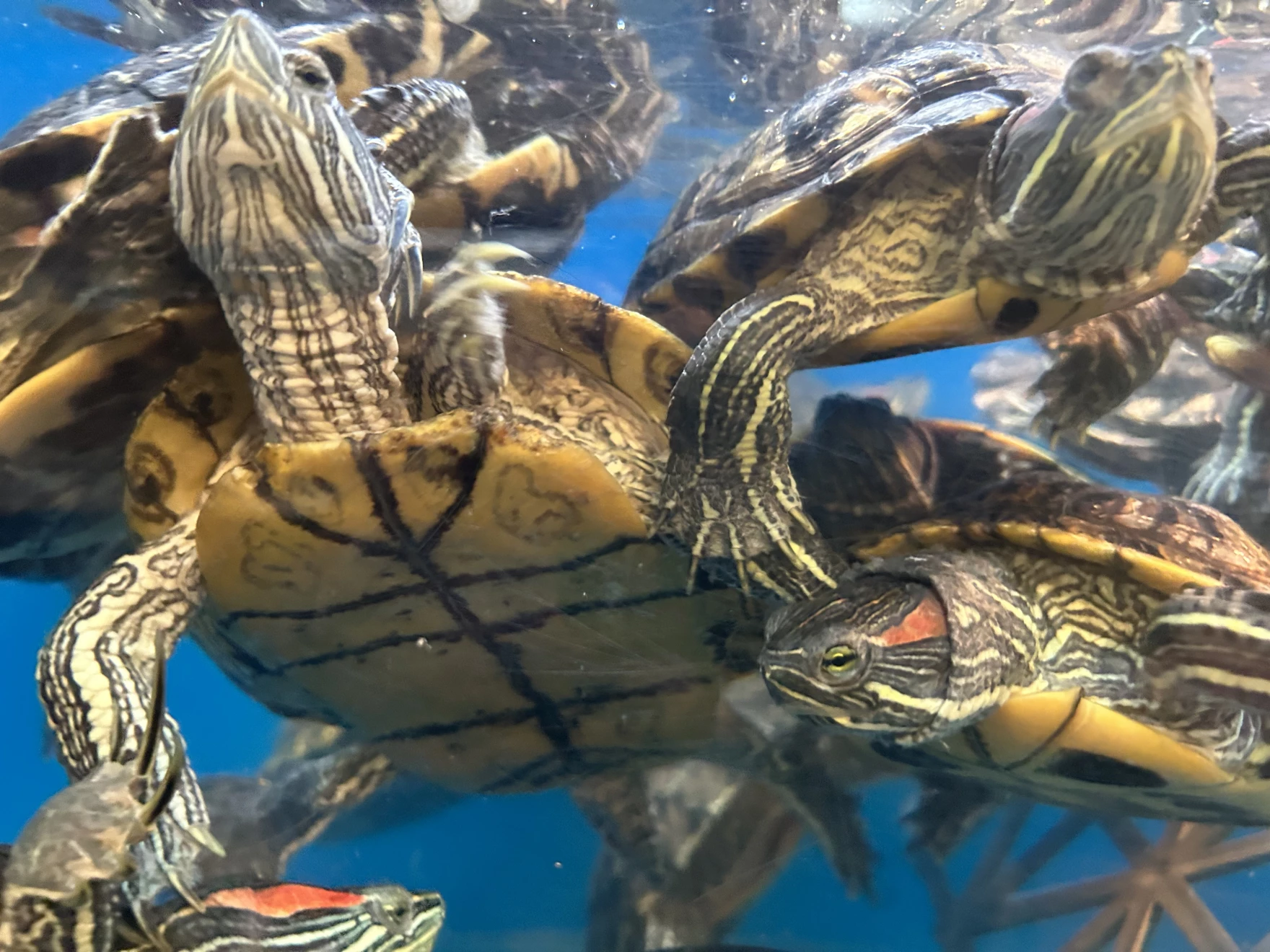
Points North is a biweekly podcast hosted by Daniel Wanschura and Morgan Springer about the land, water and inhabitants of the Upper Great Lakes.
This episode was shared here with permission from Interlochen Public Radio.
When I was 13 years old and on vacation in Florida, I bought a baby red-eared slider at a flea market. She was tiny – about the size of a silver dollar. I named my new pet, Okie – short for Okaloosa, which is the name of an island near our hotel.
I brought Okie home to Minnesota, and kept her in an aquarium in the basement. For two-and-a-half years, I cleaned her cage, gave her turtle food, and watched her grow. But, eventually, it got to be too much. It was time to let her go. So, I went to a local pond in my neighborhood and set her free. Red-eared sliders aren’t native to Minnesota, but a turtle’s a turtle, right?!
Turns out, I’m not the only one who’s done this with their pet red-eared slider. Because of this, they’ve spread from their home in the south-central U.S. to every continent except Antarctica. And, in some spots, they’re outcompeting a bunch of native species.
CREDITS:
Host / Producer: Dan Wanschura
Editor: Morgan Springer
Additional Editing: Ellie Katz, Peter Payette, Ed Ronco
Special Thanks: Michelle Stromme, Marie Stromme, Meagan Wanschura, Mark Lethaby
Music: Longtime Rye, Welcome Home Sonny, Arizona Moon, Line Exchange, Georgii, by Blue Dot Sessions
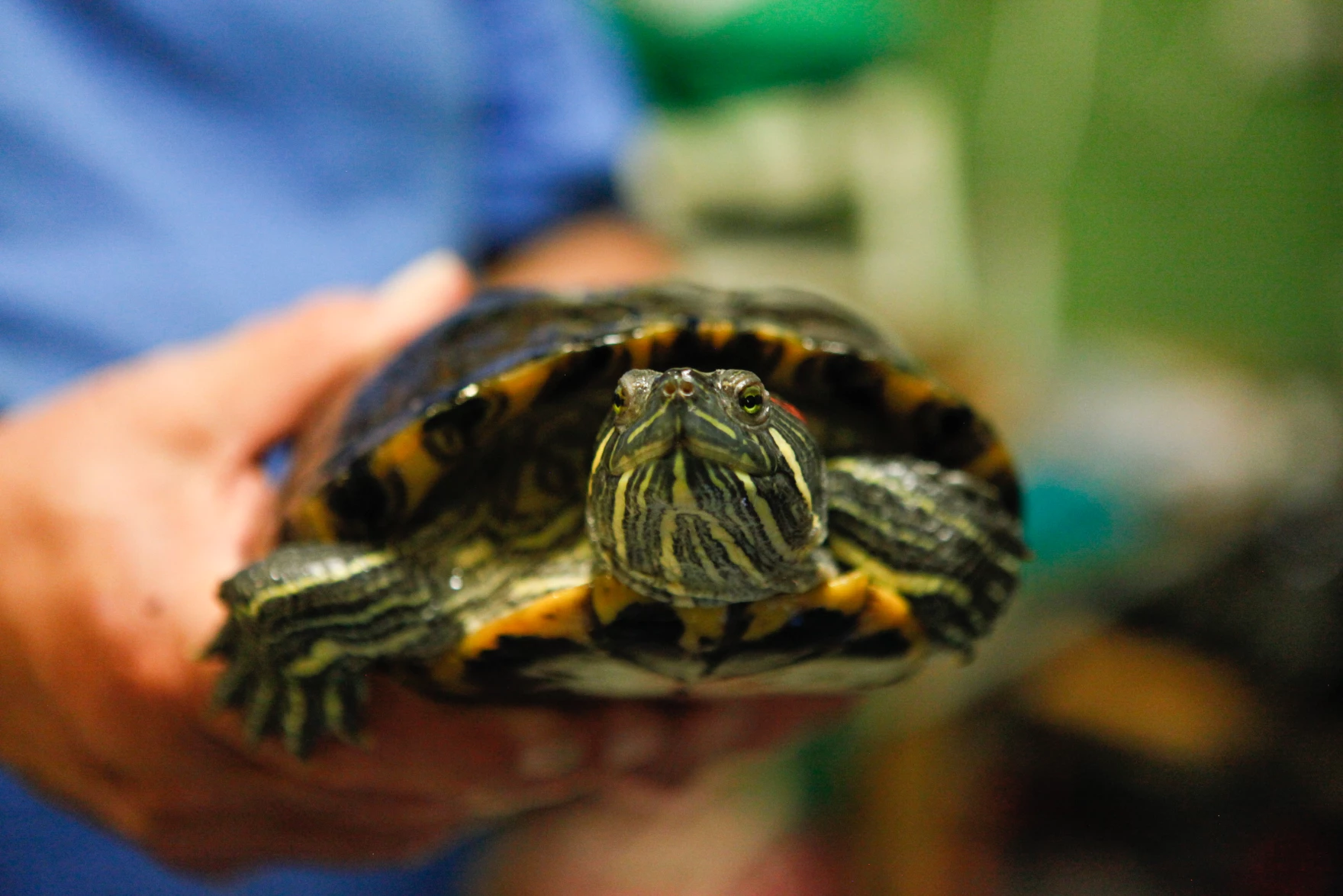
Keith Gisser holds one of about 200 red-eared sliders currently housed at Herps Alive near Cleveland, Ohio. (credit: Dan Wanschura / Points North)
TRANSCRIPT:
DAN WANSCHURA, BYLINE: This is Points North. A podcast about the land, water, and inhabitants of the Great Lakes. I’m Dan Wanschura.
When I was 11 years old, I got my first turtle. It was a small, painted turtle about four inches long. My cousin caught it for me in one of Minnesota’s 10,000 lakes. She brought it to a family gathering at my grandparents’ house in an empty ice cream bucket. I was super excited. My mom, Donna Wanschura, was not.
DONNA WANSCHURA: What I probably wasn’t happy about was that you asked someone to get you a turtle without asking us.
WANSCHURA: My turtle-keeping career was not off to a great start.
But lucky for me, I come from a long line of turtle-keeping royalty.
MIKE WANSCHURA: I’ve just always been kinda fascinated by turtles.
WANSCHURA: That’s my dad, Mike Wanschura. He used to catch turtles himself back in the day, and put them in a kiddie pool in his backyard. So, after some convincing, my parents let me keep the turtle. And I brought it back to our suburban Minnesota home. I named it Myrtle – Myrtle the turtle.
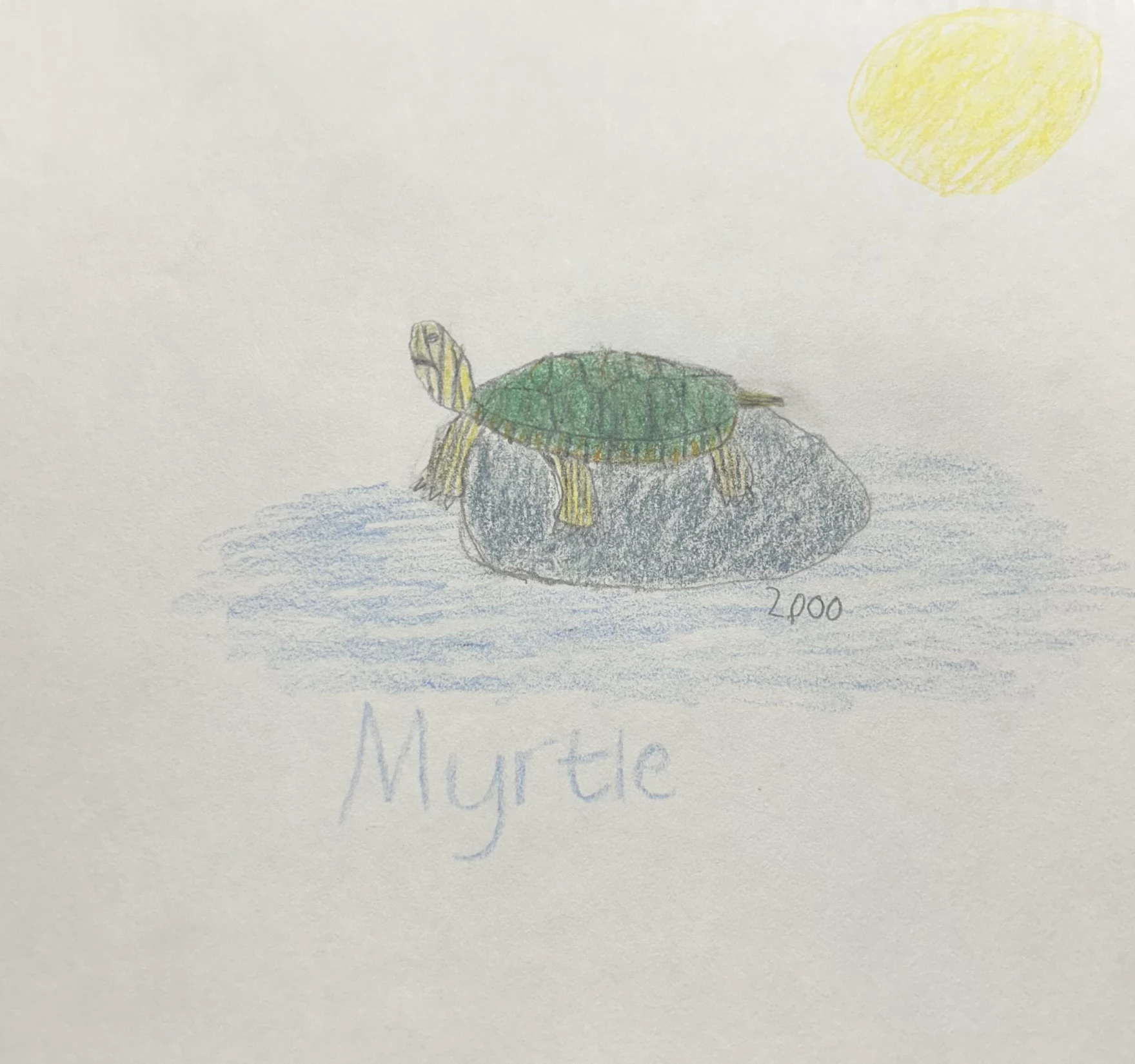
A depiction of Myrtle the turtle, by the author of this episode when he was 11 years old. (credit: Dan Wanschura / Points North)
A couple years later, my family took our annual trip to Florida. Besides the beach, one of the places we’d go is the local flea market – one gigantic yard sale infused with the smell of boiled peanuts. I was 13 and felt the fire of “vacation money” burning a hole through my wallet.
I walked by table after table, passing on souvenir t-shirts, fake designer sunglasses, some pretty nice backscratchers – and instead, went right for the baby turtles. They were red-eared sliders, named for the bright red patch right behind their eyes. And tiny – about the size of a silver dollar. Even my mom thought they were cute. So, I bought one.
I named my new turtle Okie – short for Okaloosa, which is the name of an island near where we stayed. Back then, I didn’t know much about red-eared sliders. They aren’t native to Minnesota. But a turtle’s a turtle, right? That’s what I thought, anyway.
Over the next two and a half years, Okie kept growing. The bigger she got, the more she ate, which meant my small water filter had a hard time keeping up with the steady supply of turtle poop. Eventually, she was the size of a small bowl and got to be a bit too much to handle. Okie needed to go. So, one day in August of 2005, I took Okie to a local pond and set her free.
As it turns out, I’m not the only one who’s done this. Today on Points North: What happens when people release their pets and red-eared sliders take over the world. Well, almost. That’s right after the break.
(sponsor message)
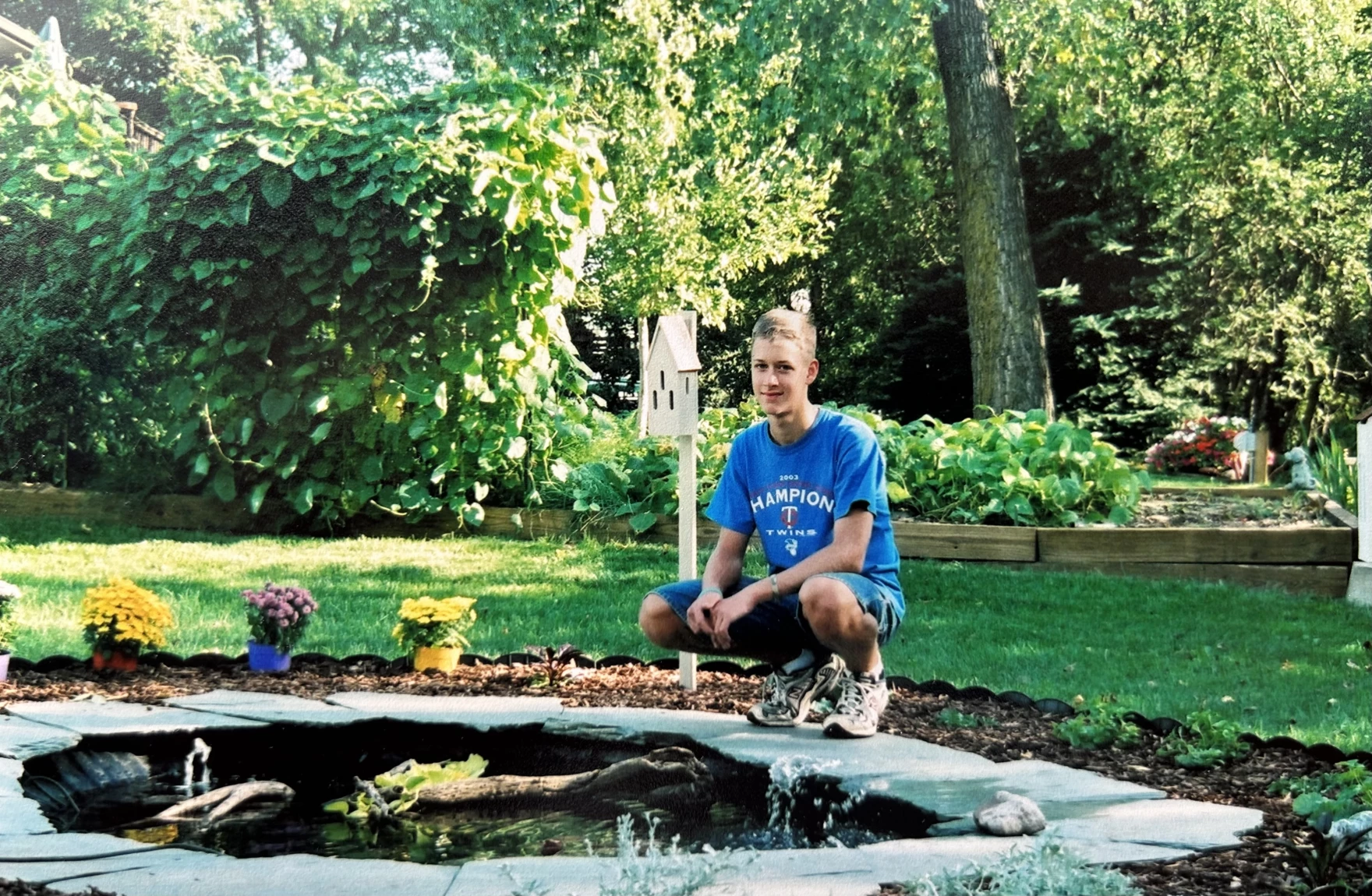
A 16-year-old Dan Wanschura poses next to a turtle pond his parents let him build in the backyard of their suburban Minnesota home in 2005. (courtesy: Donna Wanschura)
(sound of car driving by)
SARA STAHLMAN: So there’s access right here from the road. Makes it kind of easy for people to get down to the water and do what they do.
WANSCHURA: That’s Sara Stahlman. She’s at Presque Isle State Park in Erie, Pennsylvania. It’s a 32-hundred acre peninsula that curls into Lake Erie. And what people do here is dump their unwanted pets.
STAHLMAN: Yeah – turtles, goldfish – things like that.

A place on Presque Isle State Park where people pull off to the road and dump unwanted aquarium pets. (credit: Dan Wanschura / Points North)
WANSCHURA: Sara works for Pennsylvania Sea Grant. She says people usually do it out of good intentions. That’s because, like I did, most people think turtles are all pretty much the same. But that’s not true. And what’s happening at Presque Isle State Park is a good example why.
So many pet red-eared sliders have been released at Presque Isle, there’s now a breeding population – even though these turtles aren’t native here. And if you visit in the summer, there’s a good chance you’re gonna see them hanging out on a popular log.
STAHLMAN: It’s a perfect turtle log. And you can kayak around it, and you get close, and they all jump off at the same time, and it’s hilarious. And then you start to paddle away, and they all just jump right back on, so you can go back and do it again.
WANSCHURA: As fun as that sounds, these red-eared sliders are a real problem. Like any pet turtle released into the wild, they can carry disease and bacteria. And they’re notorious for outcompeting native turtles.
STAHLMAN: I always like to think of kind of the impact of invasive species as like a pie chart, and you have like this pie of resources, and it’s only so big, and it can only be sliced in so many ways, so anytime you add something in like that, especially something that’s, you know, more aggressive, and feeds heavily, and reproduces frequently, um, that pie just gets smaller and smaller.
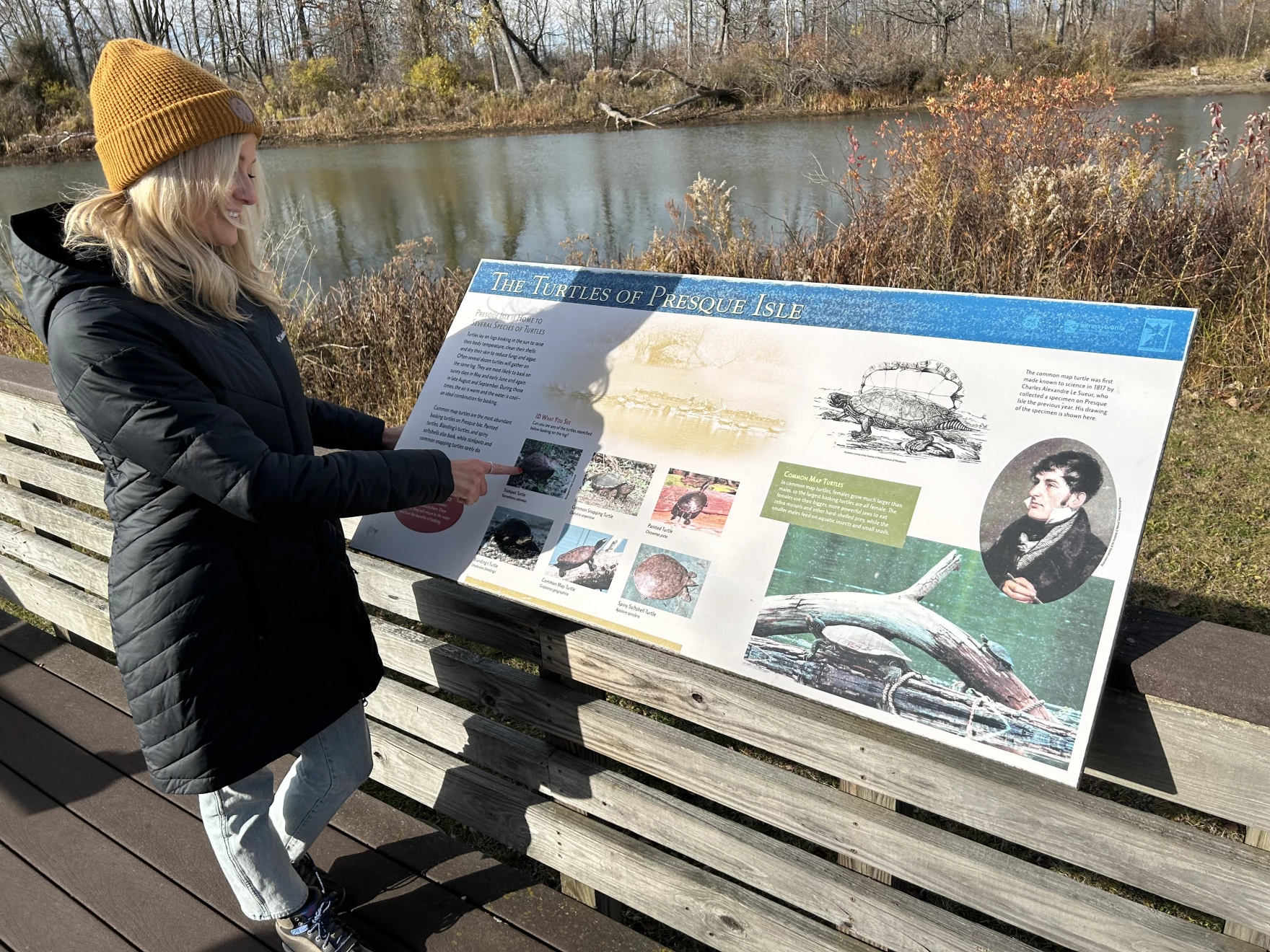
Sara Stahlman of Pennsylvania Sea Grant points out the native turtles at Presque Isle State Park. The list does not include red-eared sliders. (credit: Dan Wanschura / Points North)
WANSCHURA: Red-eared sliders are native to the south central U.S.
But because they’re popular pets and really adaptable, these turtles are now found on every continent except Antarctica. It’s a problem that goes back decades. According to the United States Geological Survey, pet red-eared sliders have been getting released all across the country since the 1930’s. And the pet turtle craze was especially high in the late 80’s and early 90’s when the Teenage Mutant Ninja Turtle cartoons were popular.
(soundbite of Teenage Mutant Ninja Turtles theme song)
Fun fact: those original turtle characters were based on red-eared sliders.
Here on Presque Isle, Pennsylvania Sea Grant attempted to get a handle on the population. From 2018 to 2021, dozens of red-eared sliders were trapped and euthanized. But it became pretty clear there were more of these turtles than what was anticipated. And trying to find and catch all of them just wasn’t going to happen. That’s when Pennsylvania Sea Grant switched focus from eradication to prevention.They now partner with various organizations to host pet take-back events. Basically, don’t let your pet red-eared slider go – turn it in instead!
(sound of door opening)
WANSCHURA: Hi Keith.
KEITH GISSER: Hi, I’ll be right with you. Give me two minutes.
WANSCHURA: You’re good.
WANSCHURA: Just outside Cleveland, Ohio, Keith Gisser runs Herps Alive. It’s a non-profit that rehabilitates and houses unwanted reptiles, with the goal of getting most of them adopted. Inside, there are rows and rows of aquariums, and plastic tubs – filled with all sorts of reptiles. But mostly red-eared sliders. A whopping 200 of them.

Some red-earded sliders bask under a UV light at Herps Alive near Cleveland, Ohio. (credit: Dan Wanschura / Points North)
GISSER: But just to give you an idea on our turtles–
WANSCHURA: Keith takes me to a back room.
GISSER: All of this, we’ve got … 13 tubs right now … each of them filled with turtles.
WANSCHURA: Literally turtles upon turtles upon turtles. Many of them the size of dinner plates. And Keith can’t get rid of them nearly as fast as he takes them in.
GISSER: One of the problems that we have is our turtles are somewhat more – I don’t want to say crowded – but we don’t keep them at … the volume of recommended water per turtle. We have no choice. So we’re about 50 percent over what they recommend, okay?
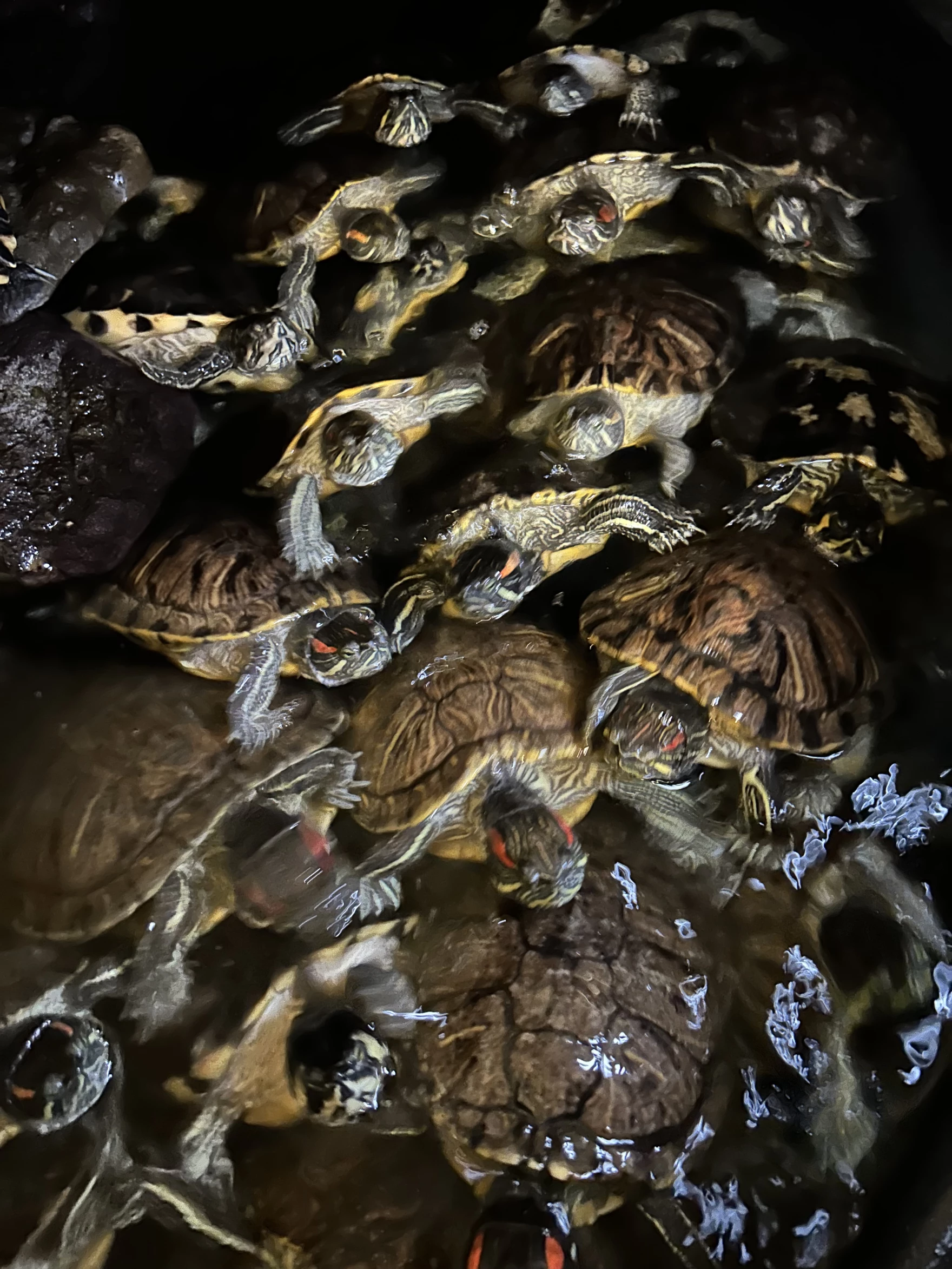
Just one of the many tubs of red-eared sliders housed at Herps Alive near Cleveland, Ohio. (credit: Dan Wanschura / Points North)
WANSCHURA: Much like me, Keith fell for reptiles early on. When he was 14, he says he used all of his paper route money to buy lizards at a local pet shop.
GISSER: Agamids from Asia, and skinks from Africa. By the time I was 15, I’d saved up enough money to buy a baby alligator.
WANSCHURA: When he was 17, he got paid to do a presentation on reptiles. And from there, Keith became the guy you brought your unwanted reptile to.
GISSER: I like to joke … you know the Mad Libs where you fill in the blank? You know, we saw you at, fill in the blank. We have a fill in the blank – we can’t keep anymore because – fill in the blank. And I would always take those animals in.
WANSCHURA: Since he founded Herps Alive in 2013, Keith’s taken in about a thousand red-eared sliders.
GISSER: And in hindsight, perhaps when we started, maybe I shouldn’t have, but you know, we set up for this. We just do the best we can. The issue becomes if we don’t take them, people are going to release them.
WANSCHURA: It’s just, it’s fascinating that, you know, like you’re, you’re taking them in that’s like a good alternative. But then when you think of like, you can only get rid of or adopt so many out, does it ever feel a little, a little hopeless, like you’re fighting a losing battle?
GISSER: Ever? Only when I’m awake. Um, we get– it’s overwhelming. It really is.

Keith Gisser founded Herps Alive near Cleveland, Ohio in 2013. (credit: Dan Wanschura / Points North)
WANSCHURA: All this reminds me of the days I kept turtles. The aquariums. The hum of the water filters. The smell of turtle food. I’m not sure what happened to my own red-eared slider, Okie once I let her go. But it’s clear to me, I was part of the problem Keith Gisser and Sarah Stahlman are now trying to manage.
WANSCHURA: So Sara, I have a confession. I grew up in Minnesota, got into turtles when I was a kid.
WANSCHURA: I tell her the whole story. About the flea market and Okie getting big.
WANSCHURA: I just took him to my neighborhood pond and let him go. What do you think?
STAHLMAN: Ah yeah, so that hits close to home. I guess I would maybe turn it back on you to say, you know, did you think you were doing the right thing there, because I really think that that’s it. I don’t feel like people are being malicious or they’re out to destroy the environment. I think they truly feel that what they’re doing is beneficial for the animal, and that there’s not going to be any ramifications of that.
WANSCHURA: Yeah, didn’t have the foresight to think through the problem, I think. Or the potential problem there.

The author of this episode hatched painted turtles from eggs he found as a kid. (credit: Dan Wanschura / Points North)
WANSCHURA: Now, I have a kid of my own. And I hope he’s a fan of turtles, just like I am. If we’re ever on vacation and he comes across an adorable red-eared slider, I’m not gonna say, “No.” Just as long as he’s ready to take care of a dinner plate for the next 40 years.
Catch more news at Great Lakes Now:
Points North: Ghost towns lost and found
Featured image: Just a few of the hundreds of red-eared sliders Herps Alive has taken in since it was founded in 2013. (credit: Dan Wanschura / Points North)




